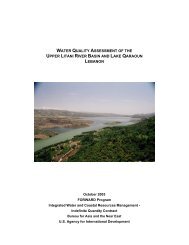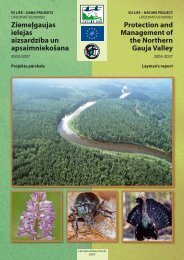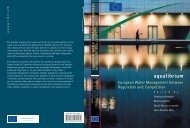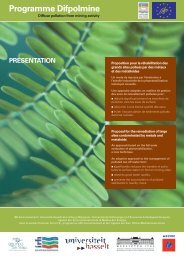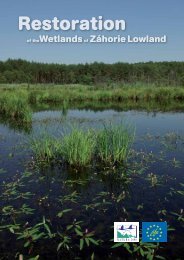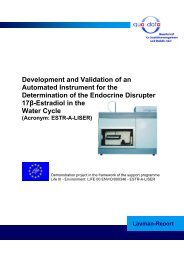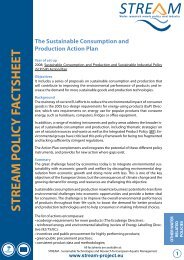Download - Hydrex Underwater Technology
Download - Hydrex Underwater Technology
Download - Hydrex Underwater Technology
Create successful ePaper yourself
Turn your PDF publications into a flip-book with our unique Google optimized e-Paper software.
EU LIFE Project ECOTEC-STC<br />
LIFE06 ENV/B/000362<br />
With the assistance of the following partners:<br />
www.hydrex.be<br />
www.portofantwerp.be<br />
www.erm.com<br />
www.hzs.be<br />
www.rijkswaterstaat.nl<br />
www.doehle.de<br />
www.interscan.net<br />
www.exmar.be<br />
www.jandenul.com<br />
2
EU Life demonstration project confirms multiple<br />
environmental and economical benefits of<br />
Ecospeed underwater hull protection technology<br />
On March 31, 2010, the EU<br />
Life demonstration project<br />
ECOTEC-STC was<br />
concluded. Over a 3.5 year period<br />
the objective of this project was to<br />
evaluate the environmental and<br />
economical benefits of Ecospeed<br />
as a biocide-free durable hull protection<br />
and antifouling system.<br />
The project was divided into several<br />
Project Tasks which were all carried<br />
out under the supervision and organization<br />
of <strong>Hydrex</strong> NV.<br />
Project Tasks<br />
A first task was to test and modify<br />
the maintenance tools to optimize<br />
the underwater treatment of STCs<br />
and to develop new prototypes.<br />
To demonstrate the ease of application<br />
and underwater treatment,<br />
several shipowners were involved<br />
as partners in the project: notably<br />
Interscan, Peter Döhle, Exmar-<br />
CMB and Codralux. Subsequent<br />
inspections gave proof of the durability<br />
of the coating.<br />
The environmental impact of application<br />
and underwater treatment<br />
was assessed by Rijkswaterstaat<br />
Zeeland, the Port of Antwerp and<br />
ERM.<br />
A risk assessment of transferring<br />
non-indigenous marine species<br />
(NIS) by underwater cleaning was<br />
carried out by ERM, Rijkswaterstaat<br />
Zeeland and the Port of<br />
Antwerp. The findings of this study<br />
Conditioning of Ecospeed test plate during<br />
experiments for the project<br />
were then at the end of the project<br />
demonstrated by an underwater<br />
treatment in the Port of Rotterdam<br />
on a 1000-TEU container vessel of<br />
the partner shipowner Peter Döhle.<br />
The fuel consumption of sister vessels<br />
from the partners Peter Döhle<br />
and Exmar-CMB was monitored<br />
over a period of two years. The analysis<br />
of the provided input was carried<br />
out in collaboration with the<br />
Hogere Zeevaartschool (Antwerp<br />
Maritime Academy) and VITO.<br />
Extensive tests with underwater cleaning equipment were carried out during the project<br />
Finally, the drag and roughness<br />
characteristics of Ecospeed were<br />
compared with those of other coatings<br />
in collaboration with VITO.<br />
3
The experimental findings of the<br />
ECOTEC-STC project were then<br />
brought together to estimate the<br />
economical and environmental<br />
impact of Ecospeed in comparison<br />
to a foul release and a copper-based<br />
spc scheme.<br />
Economical Impact<br />
The total economical impact was<br />
compared on several aspects including<br />
the application costs and<br />
increased fuel costs. It was then<br />
estimated for a 1000-TEU container<br />
vessel which was to have<br />
its Ecospeed coating regularly<br />
treated.<br />
Total Application Costs<br />
require minor touch ups whereas<br />
an spc or a foul release will require<br />
reapplication at regular<br />
intervals.<br />
Decreasing Fuel Costs<br />
Increased fuel costs are due to<br />
the added resistance characteristics<br />
There may be a higher initial cost to<br />
use and apply Ecospeed. When<br />
taken over a period of 10 years<br />
which is the warranty period for<br />
Ecospeed, the final cost will be<br />
much lower as Ecospeed will only<br />
Total economical impact over 10 years for Ecospeed is 1 /2 of spc and 3 /4 of a foul release<br />
Estimated paint costs (in€/m 2 ) for Ecospeed, a foul release and an spc scheme<br />
of each coating system. Towing tank<br />
experiments have allowed to estimate<br />
the inherent added drag<br />
levels and the rate of increase over<br />
time is estimated roughly from data<br />
available in literature. Ecospeed's<br />
decreased resistance is higher than<br />
for other coatings as regular underwater<br />
treatment is used preventatively<br />
to keep added drag caused by<br />
marine fouling under control.<br />
Moreover at the same time it will<br />
improve its surface texture and<br />
hence increase its hydrodynamic<br />
efficiency. As a result, by adjusting<br />
the treatment interval, the increased<br />
fuel costs are minimized to significantly<br />
lower levels than would be<br />
the case for an spc or foul release.<br />
4
When all the costs aspects are taken<br />
together, it is estimated that the<br />
overall economical impact of<br />
Ecospeed is about half of an spc and<br />
about 3/4 of a foul release for a<br />
1000-TEU container vessel over 10<br />
years.<br />
Ecological Impact<br />
On a global scale the potential for<br />
the reduction in fuel consumption<br />
and greenhouse gas emissions is<br />
quite enormous. The IMO currently<br />
estimates the annual fuel consumption<br />
by the world fleet at 310-350<br />
million tonnes, implying an annual<br />
CO 2 output of approximately 850<br />
million - 1.1 billion tonnes. If 80%<br />
of the world fleet would switch from<br />
biocidal antifoulings to Ecospeed,<br />
this would save an estimated 28.5<br />
million tonnes in annual fuel consumption<br />
and 90 million tonnes in<br />
annual CO 2 output.<br />
Conclusions<br />
The project ECOTEC-STC has<br />
shown that Ecospeed as a Surface<br />
Treated Coating is a valuable alternative<br />
technology to the biocidal<br />
copper based antifoulings that are<br />
currently on the market. From the<br />
project tasks that were carried out, it<br />
has been demonstrated that Ecospeed<br />
exhibits the following environmental<br />
and economical benefits:<br />
•<br />
There is no need for full re-application<br />
in drydock. After supervised<br />
application, Ecospeed comes<br />
with a guaranteed lifetime of 10<br />
years and an expected lifetime of<br />
25 years.<br />
•<br />
Ecospeed has low VOC contents<br />
and in comparison with foul<br />
release coatings or copper-based<br />
antifoulings, far fewer VOCs are<br />
emitted with each application.<br />
Regular underwater treatment of Ecospeed is at the moment a Best Available <strong>Technology</strong> to<br />
minimize the risk of transferring non-indigenous marine species<br />
•<br />
Effluent analysis has shown that<br />
Ecospeed is 100% free of biocides<br />
and therefore environmentally safe.<br />
•<br />
Regular underwater treatment of<br />
Ecospeed is put forward as a Best<br />
Available <strong>Technology</strong> to minimize<br />
the risk of transferring non-indigenous<br />
marine species (NIS).<br />
•<br />
Advanced maintenance tools have<br />
been developed to clean and condition<br />
simultaneously.<br />
•<br />
The analysis of the roughness<br />
characteristics has demonstrated<br />
an optimization of surface characteristics<br />
by underwater treatment.<br />
•<br />
Towing tank experiments have<br />
shown that conditioned Ecospeed<br />
exhibits nearly 2% less drag than a<br />
newly applied copper-based spc.<br />
The dissemination activities and<br />
events organized around the project<br />
results engendered significant interest.<br />
Proof of increased interest in<br />
Ecospeed as an alternative to antifoulings<br />
is given by the number of<br />
applications since the beginning of<br />
Presentation of the results obtained by the ECOTEC-STC project in January 2010<br />
5
Comparison of the same container ship with a conventional biocidal antifouling (left) and Ecospeed (right) after spending subsequent periods<br />
of 2.5 years operating in the Baltic Sea<br />
the project. Over 100 applications<br />
were carried out since December 1,<br />
2006, of which more than 50 were<br />
full hull applications.<br />
Transferability of<br />
ECOTEC-STC<br />
The collection of fuel consumption<br />
data is being continued in order to<br />
further demonstrate that the surface<br />
texture of Ecospeed keeps improving<br />
with each underwater treatment<br />
of combined cleaning and<br />
conditioning and therefore contrary<br />
to traditional coatings, ship performance<br />
keeps improving all through<br />
the service life of the vessel.<br />
Another important outcome of the<br />
project was the submission of the<br />
experimental results to port authorities<br />
and environmental agencies<br />
worldwide in order to allow the<br />
underwater treatment of Ecospeed.<br />
Several ports and countries have<br />
banned underwater cleaning out<br />
of concerns of pulsed release of<br />
biocides or an increased risk of<br />
transferring NIS. The experimental<br />
results and the derived criteria for<br />
environmentally safe underwater<br />
cleaning have already convinced<br />
Ice going general cargo vessel coated with Ecospeed as part of the LIFE project<br />
6
Application of Ecospeed on one of the<br />
vessels that was part of the project<br />
Oil tanker coated with Ecospeed as part of the LIFE project<br />
several economically important<br />
ports to overturn the ban.<br />
The commercially significant ports<br />
of Rotterdam, Antwerp, Copenhagen,<br />
Oslo and Barcelona, which<br />
maintained a ban on underwater<br />
cleaning, have all decided between<br />
mid 2009 and March 2010 to allow<br />
the underwater cleaning of hulls<br />
coated with Ecospeed. It is expected<br />
that the list will expand in the<br />
future. All these ports recognize<br />
the negative impact of biocidal<br />
paints and want to support environmentally<br />
safe solutions.<br />
Cleaning equipment unloaded prior to maintenance operation<br />
EU LIFE Project ECOTEC-STC<br />
LIFE06 ENV/B/000362<br />
7
Ecospeed ship hull performance technology<br />
contains no active components<br />
thus avoiding the release of toxic<br />
chemicals that takes place with antifouling<br />
paints.<br />
The coating is combined with an underwater<br />
cleaning and conditioning system,<br />
removing any marine fouling at an early<br />
stage of development. This procedure is<br />
made very easy by Ecospeed’s non-stick<br />
properties that make it difficult for fouling<br />
organisms to attach to the hull. Ecospeed’s<br />
surface characteristics steadily improve<br />
a<br />
Phone: +32 3 213 5318<br />
Fax: +32 3 213 5321<br />
with each hull cleaning throughout the<br />
service life of the vessel, setting it entirely<br />
apart from antifouling paints that deteriorate<br />
over time. Major fuel savings are<br />
the result.<br />
Because the coating is not required to<br />
be active it can be made extremely tough<br />
and durable. Besides offering excellent<br />
anti-corrosive properties, it allows the<br />
coating to last the lifetime of the vessel.<br />
The need for repaints during future drydockings<br />
is eliminated, resulting in proven<br />
substantial savings in time and cost.<br />
info@ecospeed.be<br />
www.ecospeed.be




